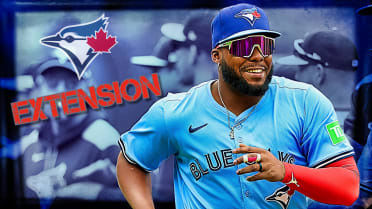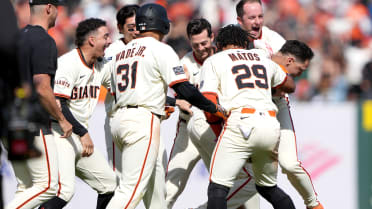Last year, Fernando Tatís Jr. had a problem.
It wasn't on offense. He slammed 22 homers, stole 16 bases, and put up a .317/.379/.590 line that was better than 53-homer slugger Pete Alonso's (in fewer plate appearances, of course).
You wouldn't think it was on defense, thanks to his nightly appearances on the highlight reels. Despite playing only half the season due to injuries, what he accomplished in that short time allowed him to finish third in the NL Rookie of the Year balloting. At 20, it was clear he was the total package. He was going to going to be baseball's next big star -- and he is.
And yet, there was a problem, and Tatis knew exactly what it was.
"I want to be great at defense," he told reporters this August. "That was a big hole for me last year, so this year we're turning the page around and becoming something different."
He's exactly right. For all of the jaw-dropping plays, Tatis actually rated as one of baseball's weakest fielders in Statcast's defensive metric Outs Above Average. (His minus-13 was tied for fifth-worst.) As we wrote in January, the problem wasn't difficult to find. "While 26 shortstops played more innings than his 731 1/3," we noted, "no one in baseball at any position had more throwing errors than his 14."
Weakest defensive shortstops, 2019 (Outs Above Average)
minus-16 Jorge Polanco
minus-14 Didi Gregorius
minus-12 Fernando Tatís Jr.
minus-9 Kevin Newman
The error total doesn't tell you the entire story -- you can make poor plays on balls that are scored as infield hits as easily as you can on ones that go down as errors -- but you get the idea. He missed half the season, yet still made enough throwing errors to get into a tie for 19th most in a season of the 30-team era (dating to 1998). As you can see from this selection here, they weren't the hard plays. They were the easy ones.
You can see that clearly in the numbers when we look at his 2019 fielding plays, and break them down by difficulty level, based on how often similar opportunities in terms of distance, time, and runner speed (on grounders) get turned into outs. If we split them into three unofficial categories of "easy," "medium," and "hard," you can see exactly the problem here.
Estimated success rate, Tatis, 2019
80-100%: minus-9 OAA
40-80%: minus-5 OAA
0-40%: +1 OAA
On the difficult plays (0-40% estimated success rate), Tatis was good, slightly above average. On the medium plays (40-80%), he was poor. On the easy plays (80-100%), he was awful. Put another way: He was better when the chance was hard than he was when it was easy.
It wasn't enough to say he couldn't be a shortstop going forward, necessarily, though it was surely concerning, and as recently as February, the Athletic (subscription required) had an article titled "Why the Padres have entertained the idea of playing Fernando Tatis Jr. in center field," after a winter where rumors about San Diego going after Cleveland shortstop Francisco Lindor had swirled.
On the contrary, there were some positive signs, because it was clear that his problem was not in getting to balls or catching them, and he was certainly not lacking in arm strength -- the types of problems that are difficult to fix. Instead, it was about whether he could clean up the rough edges, enough to stay at the position long-term.
So how's that going in 2020? So far, Tatis has played 355 1/3 innings, the most of any shortstop. He has made just a single error, and that was on a bobbled grounder, not a throw. (Look, we're not saying he has to be perfect.) When the 2020 version of infield Outs Above Average gets released shortly, he'll be at or near +1 OAA.
That may not sound like much, and it's been less than two months of baseball, but it's been a massive improvement, if a quiet one. If there was a problem, consider it solved. But how?
Tatis, in 2019, suffered from a lack of experience, to be sure. Immaturity, perhaps, as that's a word Tatis himself used to describe his 2019 fielding. Maybe some of that was going to fix itself simply with time.
But the Padres also went out and changed their coaching staff, too. Last fall, San Diego hired Bobby Dickerson to be Jayce Tingler's bench coach, as well as to work with the infielders. Dickerson had spent seven years with Baltimore, overlapping with much of Manny Machado's tenure there.
"Bobby’s still the best infield coach in the business,” former Orioles manager Buck Showalter told MLB.com in August. “When I saw that, I knew they were really getting serious.”
“What he’s been doing, the most impressive part of this is he’s been playing defense,” Machado told the San Diego Union-Tribune in August.
“It comes with maturity,” added Dickerson. “It takes a little time."
You can see that he's still making the nice plays, like this one -- given the speed of the runner, and how much time and distance Tatis had to play with, was considered barely over a 50% chance of becoming an out -- against Starling Marte ...
... but far more importantly is this selection of Tatis making regular 6-3 plays in 2020. They're not exciting. They're not boring, necessarily, but perhaps more mundane. This, of course, is entirely the point.
There's not a particular metric to point to here, that he's gotten faster, or stronger, or quicker, or anything. There's just the regular, everyday plays that weren't made before, and are being made now. It's quiet. It's the opposite of flash. It's necessary.
Because remember, the Padres' infield, in 2019, was the worst defensively in baseball, at minus-26 OAA. That wasn't entirely due to Tatis, but it sure had a lot to do with him. (Machado was not up to his usual standards, and Eric Hosmer rated poorly.) When the 2020 numbers come out, the Padres' infield this time around will be slightly above average, in part due to rookie sensation Jake Cronenworth, but mostly because Tatis isn't dragging them down any longer.
Stardom, oftentimes, is not just about the spectacular plays. It's about the routine ones, over and over and over. Last year, we weren't seeing that from Tatis. So far in 2020, he's doing it well. For all the big things at play, the little ones matter quite a bit.
Mike Petriello is a stats analyst for MLB.com, focusing on Statcast and Baseball Savant, and is also a contributor to MLB Network.




